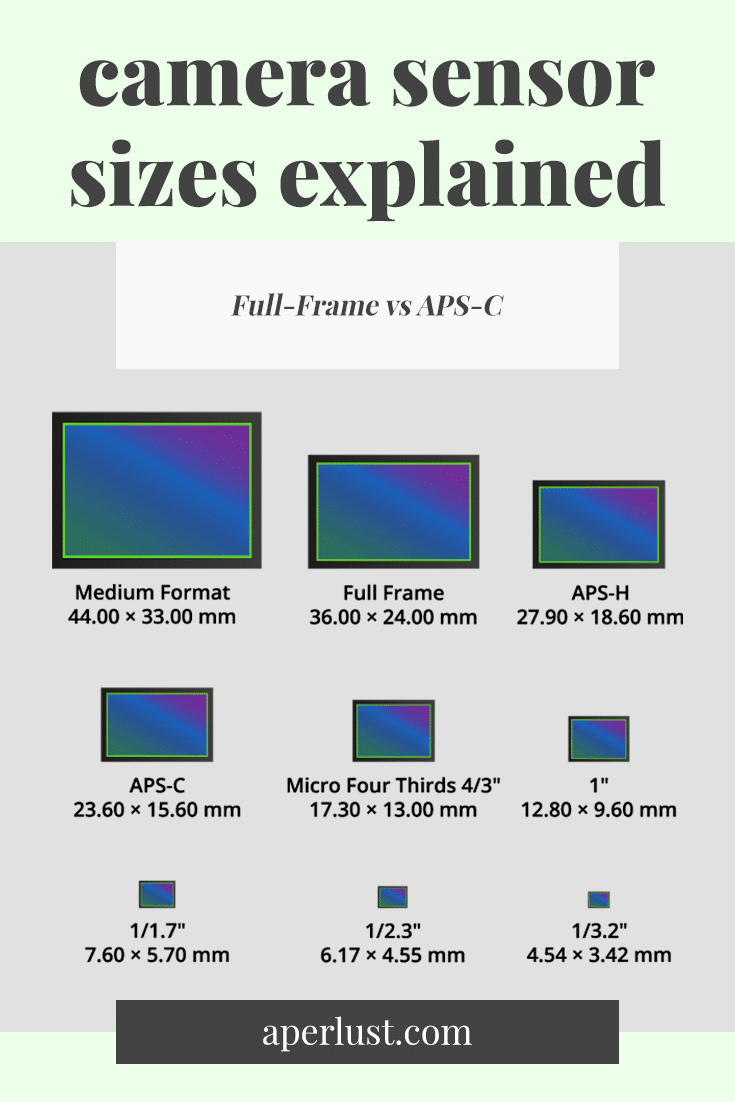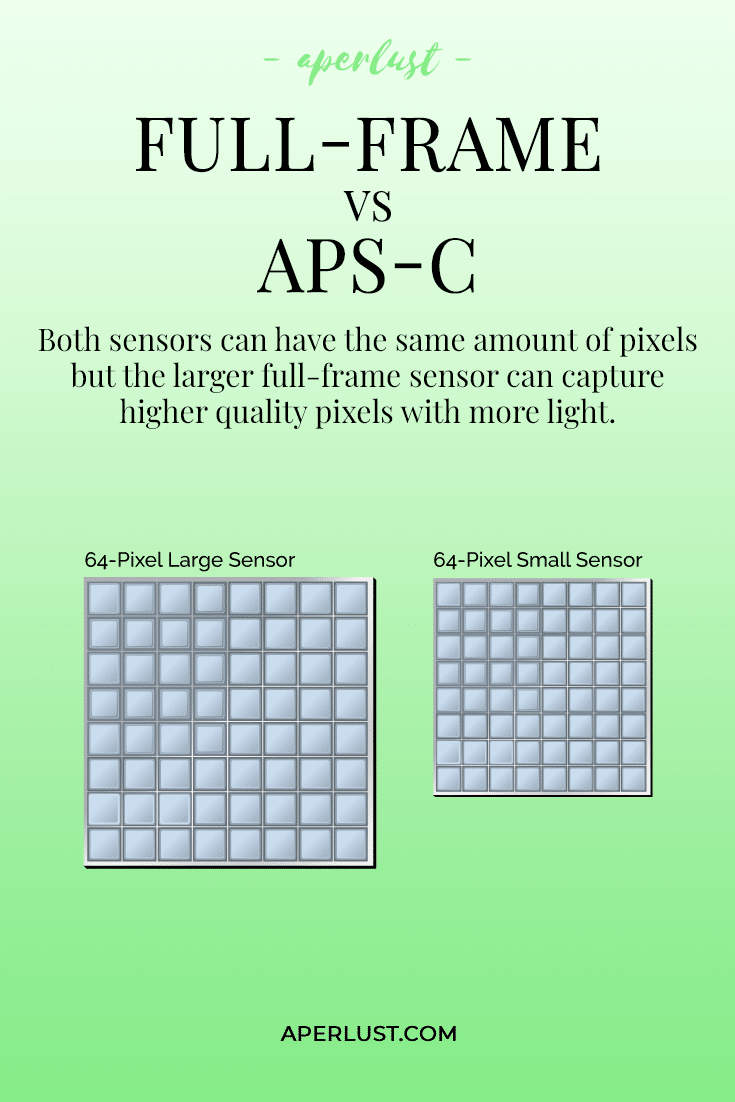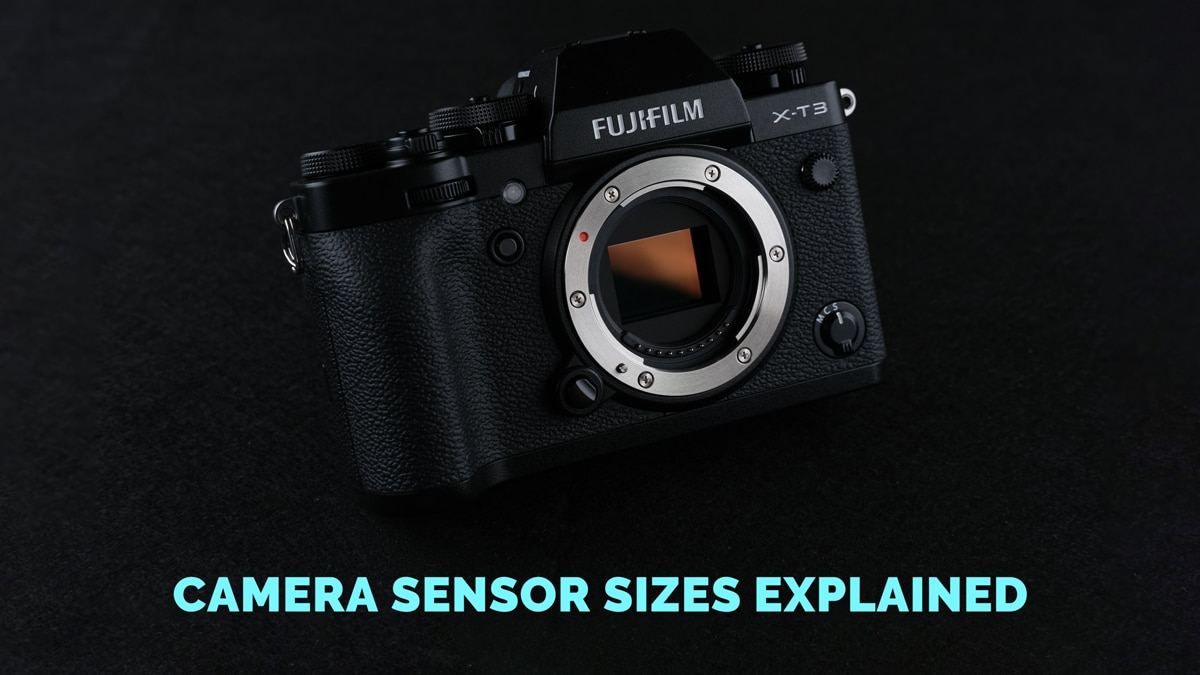Last updated on November 13th, 2022
The word ‘photography’ combines two Greek words: light and drawing. In the days of old film cameras, an image used to be created by letting the light hit a sheet of chemically-treated film, which led to the scene being captured. Now, we are more familiar with digital cameras, which use image sensors instead of film rolls.
Sensors are nothing but small electronic chips containing thousands of tiny pixels. Each pixel records the lights and colors that come through the lens.
Depending on their size, sensors can be classified as Medium Format, Full-frame, Crop sensors, etc. In this guide, we will discuss the features of these various sensors, how they affect the resolution of your camera, and which sensor may be best for your photographic needs.
Pin for Later

Different Types of Camera Sensor Sizes
1. Medium Format
The biggest image sensor put into consumer cameras these days, medium-format sensors are about 4-6 cm in length and range from $5000 to $30,000.
Although different manufacturers have varying sizes within this category, the sensor is much larger than other types – about double in size compared to entry-level DSLRs.
The advantage of a larger area is that medium format cameras provide mammoth resolutions of 100 MP and higher. The pixels are more “spread out” and can take in a lot of light, ensuring that dynamic range is the highest you can get. Also, the larger sensor means that your field of view increases, and you will capture a wider scene.
Medium format sensors are great, but the expense and large camera bodies make it suitable mainly for experienced professionals.
2. Full-Frame
More accessible than medium-format, full-frame sensors mimic the 35mm film roll that used to be put into older cameras, with dimensions of 36 x 24mm. You may not get the high megapixel count of medium-format cameras, but the overall dynamic range is still pretty close.
Full-frame cameras offer a good balance between image quality and size compared to medium format, although the price is still over the budget of most beginners.
With more affordable full-frame cameras being released by Nikon, Sony, and Canon, you can get excellent image quality at prices similar to APS-C cameras, especially if you buy an older model or find a bargain.
3. APS-C
The ‘Advanced Photo System – Type C’ sensor is the most common type found in DSLRs and mirrorless cameras on the market today. At a size of 23 x 16mm, they are quite smaller than full-frame sensors.
APS-C image sensors are also called ‘crop sensors’ or ‘cropped sensors’ because their smaller size gives an image similar to a full-frame photo that was cropped. We’ll learn more about this ‘crop factor’ in the next section.
This sensor’s excellent image quality, smaller camera sizes, and lower price make it a good choice for beginners and enthusiasts looking for a portable camera kit. In fact, almost all camera manufacturers have a more comprehensive range of crop-sensor cameras and lenses than full-frame, as most photographers and travelers prefer having such an all-purpose set-up.
4. Micro Four-Thirds
Micro four-thirds sensors are used mainly by Olympus, Panasonic, and earlier Fujifilm models in their mirrorless cameras. These image sensors are not far behind APS-C and measure close to 17 x 13mm.
Because of the rapid growth of sensor technology and autofocusing systems, modern micro 4/3″ cameras match the dynamic range of APS-C closely and offer fast focusing and subject tracking. Further, given the small size, an MFT camera and lens are much more portable and great as a hiking camera.
5. Other Smaller Image Sensors
Compact and action cameras like GoPro use even smaller sensors. The Sony RX100 uses a ‘1-inch’ sensor that measures around 13 x 8mm, while the pocket-sized Fujifilm X20 has a ‘2/3rd-inch’ sensor that is only 8 x 6mm. GoPro goes smaller with a sensor size of 6 x 4mm – which is a 1/2.3-inch sensor.
The lower megapixels and dynamic range of these cameras make them suitable for family vacations and people looking for inexpensive and similar smartphones. But the quality of the images has been improving, especially in 4K video recording.

What is a Crop Factor?
While discussing different sensor sizes, we learned that a bigger sensor captures a bigger part of the scene, whereas smaller sensors cannot capture a similarly wide area. This is essentially the ‘crop factor’ at work.
Technically speaking, the crop factor is the ratio of a full-frame sensor’s diagonal length with your sensor’s diagonal length. It is a number that shows how small or large a sensor is compared to a 35mm sensor.
For example, if your sensor has a crop factor of 2, it means that it’s half the size of a full-frame sensor, and it will, thus, effectively give you a photo with double the magnification.
Most APS-C sensors have a crop factor of 1.5x, giving you an image that is basically a “cropped” version of a full-frame photo. The higher the crop factor, the higher the amount of ‘crop’ and smaller the field of view captured.
While using smaller sensors makes it challenging to capture wide scenes unless you have the right lens, they do have their advantages.
Because of their inherent ‘zoomed in’ look, smaller sensors give an extra reach, which can be helpful when shooting wildlife. Also, using a crop sensor means that you are cutting off the edges of the frame, which would have been otherwise captured. So, you end up using the sharp, central area of your lens and get better image quality when you pair a smaller sensor with a bigger lens.
Does Sensor Size and Resolution Affect Image Quality?
When we talk about the resolution of a camera, we’re referring to the number of pixels it contains, or in other words, the megapixel count. A camera with more megapixels gives you more resolution.
By measurement standards, 1MP means 1 million pixels. Therefore, a 24MP camera captures 24 million pixels for an image via the image sensor. These pixels are divided along the length and height of the sensor, giving a resolution of 6000 by 4000 pixels.
Now, the pixel count does not have any relation to the sensor size. You can have a 24MP full-frame sensor or a 24MP APS-C sensor. But depending on the sensor size, those same pixels can behave differently.
With a larger sensor, the surface area increases, allowing the pixels to gather more light and provide an improved dynamic range without much noise. On the other hand, cramming many pixels in a small sensor with less surface area will increase the digital noise and give lower image quality.
Therefore, a rule of thumb is to choose a camera that has enough megapixels to suit your needs with the largest possible sensor. For example, a 20MP APS-C Nikon D500 will produce better photos than a smartphone with a 64MP sensor, simply because smartphone sensors are tiny and cannot physically collect enough light.
Full-Frame vs APS-C: Which One is Better?

It is essential to keep in mind that different people have different needs, and it is entirely up to the photographer to choose which image sensor size is better.
The most significant advantage of a full-frame lens is its dynamic range and low light performance. The larger surface area ensures that even ISOs of 800 and 1600 look extremely clean. Boosting shadows during editing does not significantly increase noise levels.
Of course, bigger sensors will mean a heavier, larger camera body and a hefty price tag.
Further, full-frame sensors capture a wide perspective, which means that you will have to invest in longer lenses if you want a good reach. They also offer a shallower depth of field, which is excellent for creating out-of-focus backgrounds for portraits and weddings.
APS-C sensors, meanwhile, are lighter and cheaper. Their crop factor also means that a 35mm full-frame lens will give a perspective of a 50mm one. However, you will be sacrificing a bit of dynamic range here.
With newer and better cameras being launched every day, APS-C sensors will generally work for most photographers and deliver more than sufficient dynamic range. In any case, these differences are not very significant in modern cameras unless you zoom in and compare each camera side-by-side.
And when thinking about image sensors, remember that some of the most beautiful images have been captured with small image-sensor cameras like GoPros or smartphones. Just look at Instagram.
Image quality, sharpness, and noise are all affected by the image sensor size and quality. Luckily, image-editing software can mitigate many of these concerns. For example, Topaz Denoise AI is the best noise reduction software. But Capture One and Lightroom are great at it too.
Conclusion
Image sensors are nothing but the digital version of a film roll, where the chemical sheet has been replaced by small electronic pixels. These can come in different sizes — from large medium format and full-frame sensors to smaller APS-C and micro four-thirds sensors.
The image sensor pixels collect light and convert it into electronic signals, and it’s essential to let the pixel cover a large area and gather as much light as possible. This is why bigger sensors offer better dynamic range and lower noise levels, even though they may have lesser megapixels.
Another advantage of bigger image sensors is that they let you cover a wider part of the scene, unlike small sensors, which will ‘crop’ the edges away.
Choosing between full-frame and APS-C sensors is a game of trade-off. Professionals who need the best possible image quality and can afford an expensive camera usually go for full-frame, while the portable and inexpensive APS-C is still the majority’s choice, especially when it’s used only for family photos or as a travel camera.
Related Articles:
Frequently Asked Questions
What is the best camera sensor size?
The best camera sensor size for professional photographers and enthusiasts full-frame image sensors. Generally, they provide higher quality images with less noise in low-light. On the other, larger full-frame sensors usually require a bigger camera body, especially for DSLRs. This is a dealbreaker for some photographers.
Is a bigger camera sensor better?
Yes, a bigger camera sensor is better and provides more sharp and noise-free images. Most professional photographers use full-frame camera bodies. The caveat is the bigger sensors like the full-frame (36 x 24mm) cost more than smaller ones. The cost of full-frame sensors deters beginner photographers from buying them.
How are camera sensors measured?
Camera sensors are measured by their sizes (eg. APS-C 23.6 x 15.6mm) and megapixel count. They are also visually measured in terms of image quality, sharpness, and noise.
What are the different camera sensor sizes?
Technically camera sensor sizes can come in any size, but there are the most common among the big camera manufacturers:
1. Full-Frame – 36 x 24mm
2. APS-C – 23.6 x 15.6mm
3. Micro Four-Thirds – 17.3 x 13.0mm
4. One-Inch – 13.2 x 8.8mm


there is a mistake about the crop-factor, an crop-factor of 2 doesn’t mean that the sensor is half the size of full frame but only a 1/4 of the full frame sensor. (actually 3,9/1)
This is not true: For example, if your sensor has a crop factor of 2, it means that it’s half the size of a full-frame sensor, and it will, thus, effectively give you a photo with double the magnification.